Galileo_INTRODUCTION(伽利略简介)
伽利略伽利略简介

伽利略伽利略简介职业:天文学家和物理学家国籍:意大利语为什么出名:被爱因斯坦称为现代科学之父,伽利略出生在比萨的一个音乐世家。
在学习了数学和自然哲学之后,他于1589年被任命为数学系的主席,之后又转到帕多瓦大学,在那里他在基础科学和应用科学方面有了重大发现。
其中包括一个军用指南针和一个改进版的望远镜。
后来他第一个确定了木星的卫星,并描述了我们月球的地形。
在物理学中,伽利略用重力进行实验,得出所有物体都以相同的速度加速的结论。
1633年,伽利略因支持地球绕太阳运行的观点而被判犯有异端罪,并被判处入狱。
伽利略一生发表了许多著作,包括《星光使者》和《关于两个主要世界系统的对话》。
今天木星的卫星被命名为伽利略卫星,伽利略飞船是第一个环绕木星运行的卫星。
诞生于1564年2月15日出生地:意大利佛罗伦萨公国比萨星座:水瓶座死亡于1月8日,1642年(77岁)伽利略生命中的事件1609-08-08威尼斯参议院检查伽利略的望远镜1609-08-25伽利略向威尼斯立法者演示他的第一台望远镜1610-01-07伽利略发现木星的前三个卫星:木卫一、木卫二和木卫三1610-01-08西蒙·马里乌斯。
一位德国天文学家,在伽利略1610-01-13伽利略发现木卫四的一天后,独立地发现了木星的前三颗卫星,木星第四颗卫星1612-12-28海王星的第一次观测-伽利略在没有意识到它是行星1616-02-26的情况下观测并记录了一颗“固定恒星”罗马法庭向伽利略发出禁令,要求他放弃对日心说的信仰,其中指出地球和行星围绕太阳旋转1632-02-22伽利略的“关于两个主要世界系统的对话”发表于1633-02-13意大利天文学家伽利略伽利略来到罗马接受审判之前,宗教裁判所声称相信地球围绕太阳旋转1633-06-22伽利略被迫放弃他的哥白尼教皇认为地球绕太阳运行的观点(梵蒂冈在1992年10月31日才承认这是错误的!)1737-03-12伽利略的遗体被转移到意大利佛罗伦萨的圣克罗齐教堂,1992-10-31罗马天主教会在伽利略伽利略引用了他359年的话后恢复了伽利略伽利略的地位“我不觉得有义务相信赋予我们理智、理性的同一位上帝,智商让我们放弃使用它们。
伽利略

伽利略的一生,大致可以分为三个时期:
在比萨大学任教三年(1589-1591), 在帕多瓦大学任教18年 (1592-1610), 在佛罗伦萨任托斯康大公爵的首席哲学家和数 学家(1610-1642)。
拥护”哥白尼学说” 伽利略是哥白尼学说的忠诚的拥护 者,但是在大学教学的二十多年中他一 直没有讲授哥白尼学说。 1613年他推荐卡斯特利接替他原任 比萨大学数学教授职位,卡斯特利一上 任,校方就警告他不得讲授哥白尼学说。 卡斯特利说:伽利略嘱咐过我,伽利 略教书20年中也没有讲过哥白尼学说。 然而伽利略的一系列科学上的新发现都 是与日心说不谋而合的。
科学革命的先驱
伽利略在人类思想解放和文明发展的过程 中作出了划时代的贡献。在当时的社会条件下, 为争取不受权势和旧传统压制的学术自由,为 近代科学的生长,他进行了坚持不懈的斗争, 并向全世界发出了振聋发聩的声音。 因此,他是科学革命的先驱,也可以说是 “近代科学之父”。虽然他晚年终于被剥夺了 人身自由,但他开创新科学的意志并未动摇。 他的追求科学真理的精神和成果,永远为后代 所景仰。
伽利略在科学上的贡献
伽利略在科学史上是一位难得的天才。 之所以难得,一方面他既精于理论又关心 实际问题,另一方面,他是在天文、力学、 数学三方面都有突出贡献的学者,三是在 方法论上,他既擅长于思辨论证又开系统 科学实验与观察的先河,后人称他为“科 学实验之父”。
惯性原理
伽利略提出了惯性原理,即:一个物体 一旦运动起来,便一直用同一速度沿同 样的方向不断运动。 伽利略给出了斜面上物体下落的运动规 律,他说这种情形也是匀加速运动。他 还说:“一个物体的末速度是随垂直高 度而变,而与斜面的倾角无关。”这一 结论可以看为能量守恒定律最早期的表 述。 伽利略进行了摆的实验,发现了摆周期 的等时性原理。
伽利略生平

伽利略Galileo Galilei (1564 ~ 1642)伽利略出生於意大利的比薩城,他博學多聞,他既是天文學家、數學家,又是物理學家、哲學家。
伽利略自小就表現出非凡的思考能力、製作和觀察的能力,17歲時進入在比薩大學學醫,期間得以接觸阿基米德和歐幾里德等的數學著作,奠定數學方面相當的深厚的造詣。
18歲時,一次到比薩教堂去做禮拜,他注意到那些搖擺不定的油燈,儘管擺幅不同,只要懸繩一樣長,其擺動周期便會相同。
因為伽利略常用自己的觀察和實驗,驗證教授們的理論和教條,伽利略並沒有完成他的大學學位,就回家幫父親經營店鋪,餘暇完全投注於自學及獨立研究,勤於學習數學及做實驗。
在友人吉多鮑多伯爵推薦下,伽利略擔任比薩大學的數學講座教授,主講數學及天文。
這時期的研究幾乎完全集中於有關運動方面的問題,對亞里斯多德的落體運動提出了質疑,試圖以阿基米德的”浮力原理”來解釋落體運動,認為在真空中物體下落的速度和它的密度成正比,在空氣或水中落下時,則物體的下落速度與物體和所通過的介質的密度差成正比。
實際上這段時期的伽利略並未擺脫亞里斯多德思想的影響。
1592至1610年是伽利略科學研究的黃金時期。
伽利略受聘於地中海威尼斯共和國的帕多瓦大學,此地自由的學術氣氛,鼓勵自由研究和自由思想,對伽力略來說較少的教會控制,讓他能充分發揮所長,建立他的科學宇宙觀。
在這裡伽利略研究了大量的問題:落體運動──發現物體在空氣中落下,它的速度不僅和它的重量及密度有關,還與它的大小及形狀有關,使他意識到空氣阻力的存在;斜面運動──他注意到,物體沿斜面向下運動時,速度不斷增大,沿斜面向上運動時,速度不斷減小。
這兩種運動變化的差別,完全是由於斜面傾斜的方向不同而引起的;如果一小球從一斜面滾到一個既不向下、也不向上傾斜的平面上,它將會怎樣運動呢?通過實驗,伽利略由此繼續推想,水平面如果光滑得沒有阻力呢?那結果必然是永遠運動下去的,不會停止;天文觀察--1594年,伽利略患關節炎在家休養期間,閱讀有關哥白尼日心說的書籍,引起對天文學的興趣,並以哥白尼的信徒自居。
伽利略生平及主要贡献

伽利略生平及主要贡献伽利略 Galileo (1564~1642)----意大利天文学家、力学家、哲学家。
1564年2月1 5日生于比萨,1642年1月8日卒于比萨。
伽利略家族姓伽利莱(Galilei),他的全名是Ga lileo Galilei,但现已通行称呼他的名Galileo,而不称呼他的姓。
伽利略1572年开始上学,1575年随家迁居佛罗伦萨进修道院学习。
1589年被聘为比萨大学的数学教授。
1591年到威尼斯的帕多瓦大学任教1609年回佛罗伦萨,1611年到罗马并担任林嗣科学院的院士。
1633年2月以“反对教皇,宣扬邪学”被罗马宗教裁判所判处终身监禁。
1638年以后,双目逐渐失明,晚景凄凉。
1642年1月8日逝世。
三百多年后,1979年11月10日,罗马教皇不得不在公开集会上宣布:1633年对伽利略的宣判是不公正的。
1 980年10月又提出重审这一案件,并组成一个包括不同宗教信仰的世界著名科学家委员会来研究伽利略案件的始末,研究科学同宗教的关系,研究伽利略学说的科学价值及其对现代科学思想的贡献。
主要贡献可分下列三个方面:力学伽利略是第一个把实验引进力学的科学家,他利用实验和数学相结合的方法确定了一些重要的力学定律。
1582年前后,他经过长久的实验观察和数学推算,得到了摆的等时性定律。
接着在1585年因家庭经济困难辍学。
离开比萨大学期间,他深入研究古希腊学者欧几里得、阿基米德等人的著作。
他根据杠杆原理和浮力原理写出了第一篇题为《天平》的论文。
不久又写了论文《论重力》,第一次揭示了重力和重心的实质并给出准确的数学表达式,因此声名大振。
与此同时,他对亚里士多德的许多观点提出质疑。
在1589~1591年间,伽利略对落体运动作了细致的观察。
从实验和理论上否定了统治千余年的亚里士多德关于“落体运动法则”确立了正确的“自由落体定律”,即在忽略空气阻力条件下,重量不同的球在下落时同时落地,下落的速度与重量无关。
关于伽利略的简介
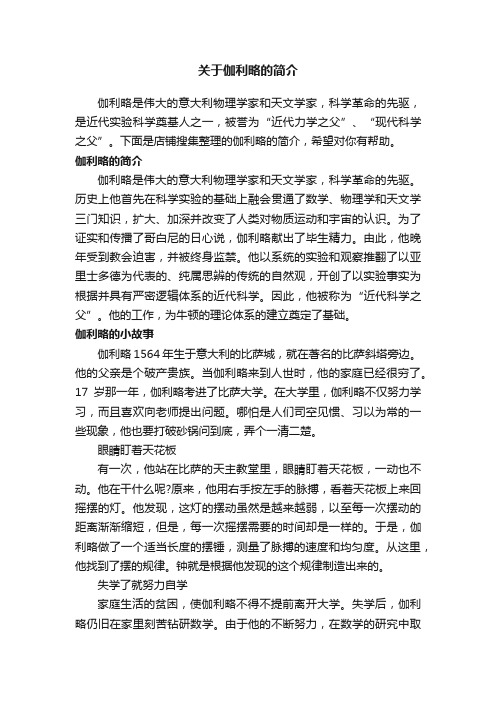
关于伽利略的简介伽利略是伟大的意大利物理学家和天文学家,科学革命的先驱,是近代实验科学奠基人之一,被誉为“近代力学之父”、“现代科学之父”。
下面是店铺搜集整理的伽利略的简介,希望对你有帮助。
伽利略的简介伽利略是伟大的意大利物理学家和天文学家,科学革命的先驱。
历史上他首先在科学实验的基础上融会贯通了数学、物理学和天文学三门知识,扩大、加深并改变了人类对物质运动和宇宙的认识。
为了证实和传播了哥白尼的日心说,伽利略献出了毕生精力。
由此,他晚年受到教会迫害,并被终身监禁。
他以系统的实验和观察推翻了以亚里士多德为代表的、纯属思辨的传统的自然观,开创了以实验事实为根据并具有严密逻辑体系的近代科学。
因此,他被称为“近代科学之父”。
他的工作,为牛顿的理论体系的建立奠定了基础。
伽利略的小故事伽利略1564年生于意大利的比萨城,就在著名的比萨斜塔旁边。
他的父亲是个破产贵族。
当伽利略来到人世时,他的家庭已经很穷了。
17岁那一年,伽利略考进了比萨大学。
在大学里,伽利略不仅努力学习,而且喜欢向老师提出问题。
哪怕是人们司空见惯、习以为常的一些现象,他也要打破砂锅问到底,弄个一清二楚。
眼睛盯着天花板有一次,他站在比萨的天主教堂里,眼睛盯着天花板,一动也不动。
他在干什么呢?原来,他用右手按左手的脉搏,看着天花板上来回摇摆的灯。
他发现,这灯的摆动虽然是越来越弱,以至每一次摆动的距离渐渐缩短,但是,每一次摇摆需要的时间却是一样的。
于是,伽利略做了一个适当长度的摆锤,测量了脉搏的速度和均匀度。
从这里,他找到了摆的规律。
钟就是根据他发现的这个规律制造出来的。
失学了就努力自学家庭生活的贫困,使伽利略不得不提前离开大学。
失学后,伽利略仍旧在家里刻苦钻研数学。
由于他的不断努力,在数学的研究中取得了优异的成绩。
同时,他还发明了一种比重秤,写了一篇论文,题目为《固体的重心》。
此时,21岁的伽利略已经名闻全国,人们称他为“当代的阿基米德”。
在他25岁那年,比萨大学破例聘他当了数学教授。
伽利略的故事

伽利略的故事伽利略·伽利莱(Galileo Galilei,1564年2月15日-1642年1月8日),意大利文艺复兴时期的一位伟大科学家,物理学家、天文学家、数学家,被誉为“现代科学之父”。
他的一生,充满了坎坷和辉煌,他的故事,也是科学史上的一段传奇。
伽利略出生在比萨的一个贵族家庭,从小就展现出了对科学的浓厚兴趣。
他曾就读于比萨大学,学习医学和数学,但后来因为家庭财政状况不佳,辍学回到家中。
然而,这并没有阻止他对科学的追求,反而更加激发了他对知识的渴望。
在他的一生中,最为人所熟知的是他对天文学的贡献。
伽利略通过自己制作的望远镜,观察到了一些前人未曾发现的天体现象,比如木星的四颗伽利略卫星、金星的光照周期等。
这些发现不仅颠覆了当时的宇宙观念,也为日后开启了现代天文学的大门。
然而,伽利略的科学观点却遭到了当时天主教会的强烈反对。
他的《星际信使》一书中提出的日心说,与当时的地心说相悖,引起了教会的不满。
在1633年,伽利略被迫在教会的压力下放弃了自己的科学观点,并且被判处终身监禁。
直到1992年,教皇约翰·保罗二世才正式宣布伽利略的观点是正确的,对他进行了平反。
伽利略的一生,是科学与宗教、理性与信仰之间的一场较量。
他不仅是一位杰出的科学家,也是一位勇敢的思想者。
他的故事,激励着后人不断追求真理,不断挑战权威,不断探索未知的领域。
总的来说,伽利略的故事,是一部科学史上的传奇。
他的勇气和智慧,影响了整个人类的思想史和科学史。
他的一生,是对知识的追求和对真理的坚持,也是对人类理性精神的崇高诠释。
他的故事,永远激励着我们,不断前行,不断探索,不断超越。
伽利略的生平事迹

伽利略的生平事迹伽利略是伟大的意大利物理学家和天文学家,科学革命的先驱。
为了证实和传播了哥白尼的日心说,伽利略献出了毕生精力。
下面是跟大家分享的伽利略事迹,欢迎大家来阅读学习~伽利略;伽利雷(Galileo Galilei,1564-1642),意大利著名数学家、物理学家、天文学家和哲学家,近代实验科学的先驱者。
1590年,伽利略在比萨斜塔上做了“两个铁球同时落地”的著名实验,从此推翻了亚里士多德“物体下落速度和重量成比例”的学说,纠正了这个持续了1900年之久的错误结论。
1609年,伽利略创制了天文望远镜(后被称为伽利略望远镜),并用来观测天体,他发现了月球表面的凹凸不平,并亲手绘制了第一幅月面图。
1610年1月7日,伽利略发现了木星的四颗卫星,为哥白尼学说找到了确凿的证据,标志着哥白尼学说开始走向胜利。
借助于望远镜,伽利略还先后发现了土星光环、太阳黑子、太阳的自转、金星和水星的盈亏现象、月球的周日和周月天平动,以及银河是由无数恒星组成等等。
这些发现开辟了天文学的新时代。
伽利略著有《星际使者》《关于太阳黑子的书信》《关于托勒密和哥白尼两大世界体系的对话》和《关于两门新科学的谈话和数学证明》。
为了纪念伽利略的功绩,人们把木卫一、木卫二、木卫三和木卫四命名为伽利略卫星。
人们争相传颂:“哥伦布发现了新大陆,伽利略发现了新宇宙”。
伽利略为牛顿的牛顿运动定律第一、第二定律提供了启示。
他非常重视数学在应用科学方法上的重要性,特别是实物与几何图形符合程度到多大的问题。
伽利略发明望远镜伽利略在帕多瓦大学工作的18年间,最初把主要精力放在他一直感兴趣的力学研究方面,他发现了物理上重要的现象;;物体运动的惯性;做过有名的斜面实践,总结了物体下落的距离与所经过的时间之间的数量关系;他还研究了炮弹的运动,奠定了抛物线理论的基础;关于加速度这个概念,也是他第一个明确提出的:甚至为了测量病人发烧时体温的升高,这位著名的物理学家还在1593年发明了第一支空气温度计……但是,一个偶然的事件,使伽利略改变了研究方向。
物理学家名人传记-伽利略

伽利略墓志铭
的没剩界因他 东有下已为失 西看什经在明 了见么没自了 。过他有然,
物理学家人物传记系列
-----伽利略· 伽利莱
伽利略· 伽利莱(Galileo Galilei )
1564年2月15-1642 年1月8(76岁)。 意大利人。 物理学家、数学家、 天文学家及哲学家, 科学革命中的重要人 物。
对伽利略的评价
“科学之父” “现代科 学之父”
“现代物理 学之父”
伽利略名言
“追求科学,需要有特殊的勇敢,思考是人类最大的 快乐。” “生命犹如铁砧,愈被敲打,愈能发出火花。” “你无法教别人任何东西,你只能帮助别人发现一些 东西。” “科学不是一个人的事业” “真理不在蒙满灰尘的权威著作中,而是在宇宙、自 然界这部伟大的无字书中。” “世界是一本以数学语言写成的书。” "一切推理都必须从观察与实验中得来。” “与其夸大胡说,不如宣布那个聪明的、智巧的、谦 逊的警句。”
物理学家人物传记系列伽利略伽利莱伽利略伽利莱galileogalilei物理学家数学家天文学家及哲学家科学革命中的重要人现代观测天文学之父现代物理学之父科学之父现代科学之父对伽利略的评价伽利略的创作成果伽利略的创作成果伽利略的创作成果伽利略的创作成果1640年关于两门新科学的谈话和数学证明伽利略的著作伽利略名言追求科学需要有特殊的勇敢思考是人类最大的快乐
“现代观测天 文学之父”伽利略来自创作成果伽利略的创作成果
伽利略的创作成果
伽利略的创作成果
伽利略的著作
1585年---《天平》 1587年---《小天平》 1588年---《固体的重心》 1610年---《星空信使》 1615年---《关于两种世界体系的对话》 1640年---《关于两门新科学的谈话和数 学证明》
望远镜鼻祖——伽利略『科学家』
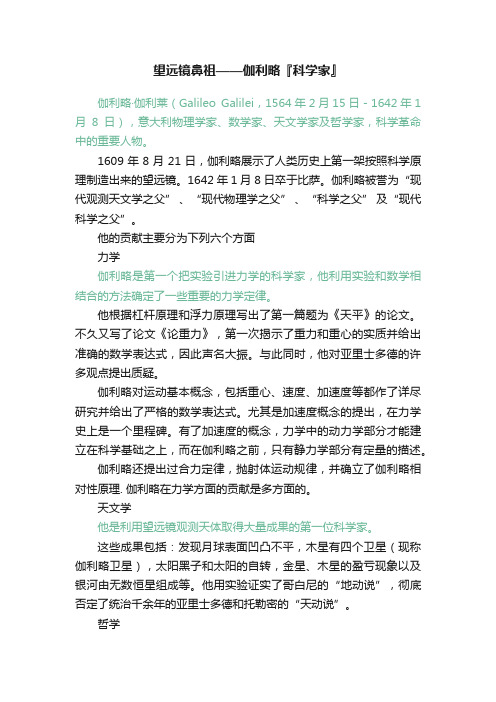
望远镜鼻祖——伽利略『科学家』伽利略·伽利莱(Galileo Galilei,1564年2月15日-1642年1月8日),意大利物理学家、数学家、天文学家及哲学家,科学革命中的重要人物。
1609年8月21日,伽利略展示了人类历史上第一架按照科学原理制造出来的望远镜。
1642年1月8日卒于比萨。
伽利略被誉为“现代观测天文学之父” 、“现代物理学之父” 、“科学之父”及“现代科学之父”。
他的贡献主要分为下列六个方面力学伽利略是第一个把实验引进力学的科学家,他利用实验和数学相结合的方法确定了一些重要的力学定律。
他根据杠杆原理和浮力原理写出了第一篇题为《天平》的论文。
不久又写了论文《论重力》,第一次揭示了重力和重心的实质并给出准确的数学表达式,因此声名大振。
与此同时,他对亚里士多德的许多观点提出质疑。
伽利略对运动基本概念,包括重心、速度、加速度等都作了详尽研究并给出了严格的数学表达式。
尤其是加速度概念的提出,在力学史上是一个里程碑。
有了加速度的概念,力学中的动力学部分才能建立在科学基础之上,而在伽利略之前,只有静力学部分有定量的描述。
伽利略还提出过合力定律,抛射体运动规律,并确立了伽利略相对性原理. 伽利略在力学方面的贡献是多方面的。
天文学他是利用望远镜观测天体取得大量成果的第一位科学家。
这些成果包括:发现月球表面凹凸不平,木星有四个卫星(现称伽利略卫星),太阳黑子和太阳的自转,金星、木星的盈亏现象以及银河由无数恒星组成等。
他用实验证实了哥白尼的“地动说”,彻底否定了统治千余年的亚里士多德和托勒密的“天动说”。
哲学他一生坚持与唯心论和教会的经院哲学作斗争,主张用具体的实验来认识自然规律,认为实验是理论知识的源泉。
他不承认世界上有绝对真理和掌握真理的绝对权威,反对盲目迷信。
他承认物质的客观性、多样性和宇宙的无限性,这些观点对发展唯物主义的哲学具有重要的意义。
但由于历史的局限性,他强调只有可归纳为数量特征的物质属性才是客观存在的。
伽利略的生平事迹

伽利略的生平事迹伽利略是伟大的意大利物理学家和天文学家,科学革命的先驱。
为了证实和传播了哥白尼的日心说,伽利略献出了毕生精力。
下面是小编跟大家分享的伽利略事迹,欢迎大家来阅读学习~伽利略的简介伽利略伽利雷(Galileo Galilei,1564-1642),意大利著名数学家、物理学家、天文学家和哲学家,近代实验科学的先驱者。
1590年,伽利略在比萨斜塔上做了两个铁球同时落地的著名实验,从此推翻了亚里士多德物体下落速度和重量成比例的学说,纠正了这个持续了1900年之久的错误结论。
1609年,伽利略创制了天文望远镜(后被称为伽利略望远镜),并用来观测天体,他发现了月球表面的凹凸不平,并亲手绘制了第一幅月面图。
1610年1月7日,伽利略发现了木星的四颗卫星,为哥白尼学说找到了确凿的证据,标志着哥白尼学说开始走向胜利。
借助于望远镜,伽利略还先后发现了土星光环、太阳黑子、太阳的自转、金星和水星的盈亏现象、月球的周日和周月天平动,以及银河是由无数恒星组成等等。
这些发现开辟了天文学的新时代。
伽利略著有《星际使者》《关于太阳黑子的书信》《关于托勒密和哥白尼两大世界体系的对话》和《关于两门新科学的谈话和数学证明》。
为了纪念伽利略的功绩,人们把木卫一、木卫二、木卫三和木卫四命名为伽利略卫星。
人们争相传颂:哥伦布发现了新大陆,伽利略发现了新宇宙。
伽利略为牛顿的牛顿运动定律第一、第二定律提供了启示。
他非常重视数学在应用科学方法上的重要性,特别是实物与几何图形符合程度到多大的问题。
伽利略发明望远镜伽利略在帕多瓦大学工作的18年间,最初把主要精力放在他一直感兴趣的力学研究方面,他发现了物理上重要的现象物体运动的惯性;做过有名的斜面实践,总结了物体下落的距离与所经过的时间之间的数量关系;他还研究了炮弹的运动,奠定了抛物线理论的基础;关于加速度这个概念,也是他第一个明确提出的:甚至为了测量病人发烧时体温的升高,这位著名的物理学家还在1593年发明了第一支空气温度计但是,一个偶然的事件,使伽利略改变了研究方向。
近代科学之父伽利略
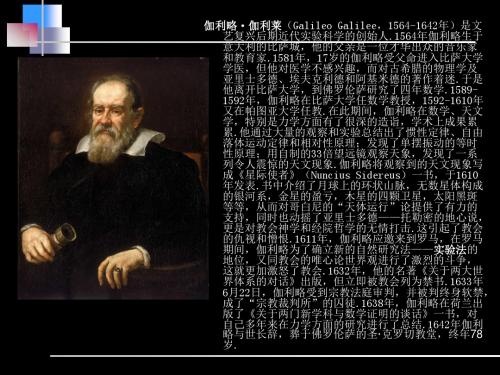
伽利略的成就
伽 利 略 望 远 镜 观 测 天 文 学 为 牛 顿 理 论 体 系 的 建 立 奠 定 基 础
实验设计
伽利略斜面实验
铜壶漏滴
பைடு நூலகம்论外推
等末速度法:物体从相同的位置经不同的路途 落于同一高度,终了速度大小相等 。
A1 B1 B2
h
A2
l
tA l tB h
若 l tB
2
则 h tA
伽利略的科学方法
外推至 落体运动 对假说修 正和推广
s∝ t2
重的物体下 落得比轻的 物体快?
对推论 进行检验 逻辑(数学) 得出推论 小球在斜面 上运动实验
提出假设
v∝ t
对现象的 一般观察
常听人说,伽利略之所以成为近代科学之父, 是由于它以经验的、实验的方法替代思辨的、演绎的 方法。但我认为,这种理解是经不起严格审查的,任 何一种经验的方法都有其思辨概念和思辨体系;而且 任何一种思辨思维,它的概念经过比较仔细的考察之 后,都会显露出他们所赖以产生的经验材料。把经验 的态度同演绎得态度截然对立起来,那是错误的,而 且也不代表伽利略的思想…….况且,伽利略所掌握 的实验方法是很不完备的,只有最大胆的思辨才有可 能把经验材料之间的空隙弥补起来。总而言之,伽利 略的方法是理论和实验相结合的方法。
伽利略的力学研究工作所蕴含的科学方法
3.实验方法 物理实验方法是指人们根据研究的目的,利用物理仪器设备,人为地控制或模拟物理现 象,排除各种偶然、次要因素的干扰,突出主要因素,在有利的条件下能重复地去研究物理 现象及其规律。实验方法是探索物理现象及其规律的基本方法,是获取第一手科研资料重要 的和有力的手段。实验方法是探索自然奥秘创立新理论的必由之路。实验方法也是检验真理 的标准和推动自然科学技术发展重要的途径。从上述伽利略开展的研究工作中,我们不难发 现,他采用的是以他开创的实验方法为核心的一系列近代科学研究的方法,以自由落体问题 为突破口,开创了近代力学的先河。为了验证结论的正确性,他通过上百次的斜面实验。在 实验中,他丢开一些次要因素,抓住问题的根本,如他知道小球在从斜面滚下的过程中,摩 擦力是不可避免的,但可力求使之减到最低的限度。这样一来,摩擦力可小到忽略不计,就 可使计量问题大为简化。他采用磨得很光的平面,再铺以羊皮纸,羊皮纸也尽可能平滑光亮, 所用的黄铜球也打磨得很光滑,由此保证了摩擦力小到可忽略不计的条件。他所使用的方法 就是简化和纯化研究对象,让研究对象在纯粹的状态下展现出它的特征,从而获得对认识对 象的正确认识。针对当时还没有精确的测时装置的情况下,伽利略在实验中还独创性地使用 了滴水称量法,将实验过程中流出的水滴在精确的天平上称量,以水重之比推出时间之比。 伽利略在实验过程中把科学的推理和实验的事实紧密地结合起来,把数学与实验的结果紧密 地结合起来。 伽利略在推导“惯性定律”的过程中,还第一次采用了理想实验的方法。他首先假定小 球从一个无摩擦的斜面上滚下来,然后在一个无限延伸的光滑平面上运动。很显然,没有摩 擦的斜面和无限延的平面是不存在的。这些实验虽然只是想象中的实验,但它是建立在可靠 的事实基础上的,这种抽象的方法既弥补了实验条件的限制,所得的结论又能令人信服。
伽利略
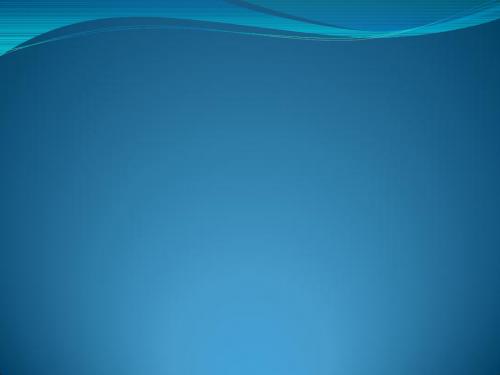
实验结果谢谢, 再见亚里士多德的学说提出了疑问。他想,同样是一磅重的东西,自然以同样速 度下落。但是,如果把两个一磅重的东西捆在一起,或者把一百个一磅重的 东西捆在一起,那么根据亚里土多德的学说,它们下落的速度就会比一磅重 的东西大一倍或者九十九倍,这可能吗?他决心亲自动手试一试。 伽利略选择了比萨斜塔作试验场。有一天,他带了两个大小一样,但重量不 等,一个重一百磅的实心铁球,一个重一磅的空心铁球,登上了五十多米高 的斜塔。塔下,站满了前来观看的人。大家议论纷纷,有人讥笑他:“这个 青年一定是疯了,让他胡闹去罢!亚里士多德的理论还会错吗!”
目录
伽利略个人简介
伽利略·伽利莱(1564年2月15日-1642年1月8日),
意大利物理学家、数学家、天文学家及哲学家,科学 革命中的重要人物。其成就包括改进望远镜和其所带 来的天文观测,以及支持哥白尼的日心说。伽利略做 实验证明,感受到引力的物体并不是呈匀速运动,而 是呈加速度运动;物体只要不受到外力的作用,就会 保持其原来的静止状态或匀速运动状态不变。他的工 作,为牛顿的理论体系的建立奠定了基础。1609年8月 21日,伽利略展示了人类历史上第一架按照科学原理 制造出来的望远镜。1642年1月8日卒于比萨。伽利略 被誉为“现代观测天文学之父” 、“现代物理学之 父” 、“科学之父” 及“现代科学之父”。
伽利略 备受讥 讽
实验过程
落体问题,人们很早就注意到了。在伽利略之前,古希腊的亚里士多德的学 说认为,物体下落的快慢是不一样的。它的下落速度和它的重量成正比,物 体越重,下落的速度越快。比如说,十公斤重的物体,下落的速度要比一公 斤重的物体快十倍。 一千七百多年来,在书本里,在学校的讲台上,一直把这个违背自然规律的 学说当作圣经来讲述,没有任何人敢去怀疑它。这是因为,亚里士多德提出 过 “地球中心说”,它符合奴隶主阶级和封建统治阶级的利益,因此,亚里 士多德的其它学说也就得到了保护。 年轻的伽利略没有被这个庞然大物吓倒。他根据自己的经验推理,大胆地对
伽利略简介_学习资料(精华版)
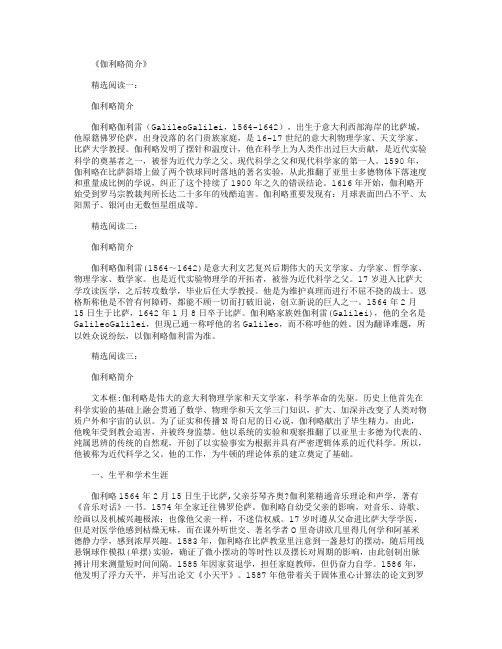
《伽利略简介》精选阅读一:伽利略简介伽利略伽利雷(GalileoGalilei,1564-1642),出生于意大利西部海岸的比萨城,他原籍佛罗伦萨,出身没落的名门贵族家庭,是16-17世纪的意大利物理学家、天文学家、比萨大学教授。
伽利略发明了摆针和温度计,他在科学上为人类作出过巨大贡献,是近代实验科学的奠基者之一,被誉为近代力学之父、现代科学之父和现代科学家的第一人。
1590年,伽利略在比萨斜塔上做了两个铁球同时落地的著名实验,从此推翻了亚里士多德物体下落速度和重量成比例的学说,纠正了这个持续了1900年之久的错误结论。
1616年开始,伽利略开始受到罗马宗教裁判所长达二十多年的残酷迫害。
伽利略重要发现有:月球表面凹凸不平、太阳黑子、银河由无数恒星组成等。
精选阅读二:伽利略简介伽利略伽利雷(1564~1642)是意大利文艺复兴后期伟大的天文学家、力学家、哲学家、物理学家、数学家。
也是近代实验物理学的开拓者,被誉为近代科学之父。
17岁进入比萨大学攻读医学,之后转攻数学,毕业后任大学教授。
他是为维护真理而进行不屈不挠的战士。
恩格斯称他是不管有何障碍,都能不顾一切而打破旧说,创立新说的巨人之一。
1564年2月15日生于比萨,1642年1月8日卒于比萨。
伽利略家族姓伽利雷(Galilei),他的全名是GalileoGalilei,但现已通一称呼他的名Galileo,而不称呼他的姓。
因为翻译难题,所以姓众说纷纭,以伽利略伽利雷为准。
精选阅读三:伽利略简介文本框:伽利略是伟大的意大利物理学家和天文学家,科学革命的先驱。
历史上他首先在科学实验的基础上融会贯通了数学、物理学和天文学三门知识,扩大、加深并改变了人类对物质户外和宇宙的认识。
为了证实和传播N哥白尼的日心说,伽利略献出了毕生精力。
由此,他晚年受到教会迫害,并被终身监禁。
他以系统的实验和观察推翻了以亚里士多德为代表的、纯属思辨的传统的自然观,开创了以实验事实为根据并具有严密逻辑体系的近代科学。
伽利略生平简介

伽利略生平简介
威尼斯出身的伽利略(1564-1642),是西欧科学史上重要的物理学家、天文学家和
数学家,也是现代科学的创始人之一,推动了西欧文化的迈向新纪元的发展,在西欧科学
史上有着重要的地位。
伽利略出生于贫穷的家庭,出于贫穷他被迫辍学,1579年被入读威尼斯大学,1581
年取得法学学士学位,后开始考研数学,1603年考得硕士学位,成为威尼斯等区域的数学家。
伽利略从1609-1619年间研究古典宇宙结构,由开普勒提出的日心说。
他利用教堂里
捐赠的新奥尔特望远镜,发现了木星有四颗卫星,被视为一项重大发现,打破了教条式宇
宙观念,并拓宽了科学发现的领域。
而一些新奇又重要的研究成果,成为另一项重大贡献。
1613年,伽利略指出,地球绕太阳运动的速度比开普勒所认为的要低。
1619年,他
研究运动的规律,提出了“通用运动规律”,即物体加速下落的规律,也就是所谓的“重
力规律”。
1629年他出版了一本标志性的著作《日心说》,提出了宇宙的一般性准则,内容涉及太阳系的内部结构和力学惯性,促进了现代物理学、力学和天文学的发展,被誉为物理、
数学和天文学的巨大贡献者。
1642年,伽利略死于病痛折磨,但他给后世留下了无价的发现,出现在现代天文学和物理学家的世界里,伽利略的故事仍然长存,引领着西欧科学的进步。
伽利略的简介及名言名句
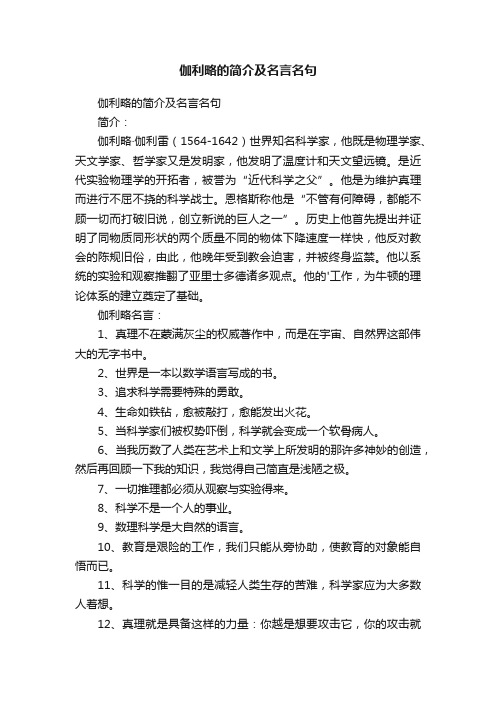
伽利略的简介及名言名句伽利略的简介及名言名句简介:伽利略·伽利雷(1564-1642)世界知名科学家,他既是物理学家、天文学家、哲学家又是发明家,他发明了温度计和天文望远镜。
是近代实验物理学的开拓者,被誉为“近代科学之父”。
他是为维护真理而进行不屈不挠的科学战士。
恩格斯称他是“不管有何障碍,都能不顾一切而打破旧说,创立新说的巨人之一”。
历史上他首先提出并证明了同物质同形状的两个质量不同的物体下降速度一样快,他反对教会的陈规旧俗,由此,他晚年受到教会迫害,并被终身监禁。
他以系统的实验和观察推翻了亚里士多德诸多观点。
他的'工作,为牛顿的理论体系的建立奠定了基础。
伽利略名言:1、真理不在蒙满灰尘的权威著作中,而是在宇宙、自然界这部伟大的无字书中。
2、世界是一本以数学语言写成的书。
3、追求科学需要特殊的勇敢。
4、生命如铁钻,愈被敲打,愈能发出火花。
5、当科学家们被权势吓倒,科学就会变成一个软骨病人。
6、当我历数了人类在艺术上和文学上所发明的那许多神妙的创造,然后再回顾一下我的知识,我觉得自己简直是浅陋之极。
7、一切推理都必须从观察与实验得来。
8、科学不是一个人的事业。
9、数理科学是大自然的语言。
10、教育是艰险的工作,我们只能从旁协助,使教育的对象能自悟而已。
11、科学的惟一目的是减轻人类生存的苦难,科学家应为大多数人着想。
12、真理就是具备这样的力量:你越是想要攻击它,你的攻击就越是充实了和证明了它。
13、你无法教别人任何东西,你只能帮助别人发现一些东西。
14、当我历数了人类在艺术上和文学上所发明的那许多神妙的创造,然后再回顾一下我的知识,我觉得自己简直是浅陋之极。
15、科学的真理不应该在古代圣人的蒙着灰尘的书上去找,而应该在实验中和以实验为基础的理论中去找。
真正的哲学是写在那本经常在我们眼前打开着的最伟大的书里面的,这本书就是宇宙,就是自然界本身,人们必须去读它。
关于伽利略的简介

关于伽利略的简介伽利略是伟大的意大利物理学家和天文学家,科学革命的先驱,是近代实验科学奠基人之一,被誉为“近代力学之父”、“现代科学之父”。
下面是店铺搜集整理的伽利略的简介,希望对你有帮助。
伽利略的简介伽利略是伟大的意大利物理学家和天文学家,科学革命的先驱。
历史上他首先在科学实验的基础上融会贯通了数学、物理学和天文学三门知识,扩大、加深并改变了人类对物质运动和宇宙的认识。
为了证实和传播了哥白尼的日心说,伽利略献出了毕生精力。
由此,他晚年受到教会迫害,并被终身监禁。
他以系统的实验和观察推翻了以亚里士多德为代表的、纯属思辨的传统的自然观,开创了以实验事实为根据并具有严密逻辑体系的近代科学。
因此,他被称为“近代科学之父”。
他的工作,为牛顿的理论体系的建立奠定了基础。
伽利略的小故事伽利略1564年生于意大利的比萨城,就在著名的比萨斜塔旁边。
他的父亲是个破产贵族。
当伽利略来到人世时,他的家庭已经很穷了。
17岁那一年,伽利略考进了比萨大学。
在大学里,伽利略不仅努力学习,而且喜欢向老师提出问题。
哪怕是人们司空见惯、习以为常的一些现象,他也要打破砂锅问到底,弄个一清二楚。
眼睛盯着天花板有一次,他站在比萨的天主教堂里,眼睛盯着天花板,一动也不动。
他在干什么呢?原来,他用右手按左手的脉搏,看着天花板上来回摇摆的灯。
他发现,这灯的摆动虽然是越来越弱,以至每一次摆动的距离渐渐缩短,但是,每一次摇摆需要的时间却是一样的。
于是,伽利略做了一个适当长度的摆锤,测量了脉搏的速度和均匀度。
从这里,他找到了摆的规律。
钟就是根据他发现的这个规律制造出来的。
失学了就努力自学家庭生活的贫困,使伽利略不得不提前离开大学。
失学后,伽利略仍旧在家里刻苦钻研数学。
由于他的不断努力,在数学的研究中取得了优异的成绩。
同时,他还发明了一种比重秤,写了一篇论文,题目为《固体的重心》。
此时,21岁的伽利略已经名闻全国,人们称他为“当代的阿基米德”。
在他25岁那年,比萨大学破例聘他当了数学教授。
- 1、下载文档前请自行甄别文档内容的完整性,平台不提供额外的编辑、内容补充、找答案等附加服务。
- 2、"仅部分预览"的文档,不可在线预览部分如存在完整性等问题,可反馈申请退款(可完整预览的文档不适用该条件!)。
- 3、如文档侵犯您的权益,请联系客服反馈,我们会尽快为您处理(人工客服工作时间:9:00-18:30)。
2
Galileo INTRODUCTION2
Galileo was born near Pisa, on February 15, 1564. His father, Vincenzo Galilei, played an important role in the musical revolution from medieval polyphony to harmonic modulation. Just as Vincenzo saw that rigid theory stifled new forms in music, so his eldest son came to see Aristotelian physical theology as limiting scientific inquiry. Galileo was taught by monks at Vallombrosa and then entered the University of Pisa in 1581 to study medicine. He soon turned to philosophy and mathematics, leaving the university without a degree in 1585. For a time he tutored privately and wrote on hydrostatics and natural motions, but he did not publish. In 1589 he became professor of mathematics at Pisa, where he is reported to have shown his students the error of Aristotle’s belief that speed of fall is proportional to weight, by dropping two objects of different weight simultaneously from the Leaning Tower. His contract was not renewed in 1592, probably because he contradicted Aristotelian professors. The same year, he was appointed to the chair of 3 mathematics at the University of Padua, where he remained until 1610.
Galileo INTRODUCTION 伽利略简介
• Italian physicist and astronomer Galileo maintained that the earth revolved around the sun, disputing the belief held by the Roman Catholic church that the earth was the center of the universe. He refused to obey orders from Rome to cease discussions of his theories and was sentenced to life imprisonment. It was not until 1984 that a papal commission acknowledged that the church was wrong.
Galileo INTRODUCTION3
At Padua, Galileo invented a calculating "compass" for the practical solution of mathematical problems. He turned from speculative physics to careful measurements, discovered the law of falling bodies and of the parabolic path of projectiles, studied the motions of pendulums, and investigated mechanics and the strength of materials. He showed little interest in astronomy, although beginning in 1595 he preferred the Copernican theory (see Astronomy: The Copernican Theory)— that the earth revolves around the sun—to the Aristotelian and Ptolemaic assumption that planets circle a fixed earth. Only the Copernican model supported Galileo’s tide theory, which was based on motions of the earth. In 1609 he heard that a spyglass had been invented in Holland. In August of that year he presented a telescope, about as powerful as a modern field glass, to the doge of Venice. Its value for naval and maritime operations resulted in the doubling of his salary and his assurance of lifelong tenure as a professor. 4
5
Galileo INTRODUCTION5
Professors of philosophy scorned Galileo’s discoveries because Aristotle had held that only perfectly spherical bodies could exist in the heavens and that nothing new could ever appear there. Galileo also disputed with professors at Florence and Pisa over hydrostatics, and he published a book on floating bodies in 1612. Four printed attacks on this book followed, rejecting Galileo’s physics. In 1613 he published a work on sunspots and predicted victory for the Copernican theory. A Pisan professor, in Galileo’s absence, told the Medici (the ruling family of Florence as well as Galileo’s employers) that belief in a moving earth was heretical. In 1614 a Florentine priest denounced Galileists from the pulpit. Galileo wrote a long, open letter on the irrelevance of biblical passages in scientific arguments, holding that interpretation of the Bible should be adapted to increasing knowledge and that no scientific position should 6 ever be made an article of Roman Catholic faith.
Galileo INTRODUCTION4
By December 1609, Galileo had built a telescope of 20 times magnification, with which he discovered mountains and craters on the moon. He also saw that the Milky Way was composed of stars, and he discovered the four largest satellites of Jupiter. He published these findings in March 1610 in The Starry Messenger (trans. 1880). His new fame gained him appointment as court mathematician at Florence; he was thereby freed from teaching duties and had time for research and writing. By December 1610 he had observed the phases of Venus, which contradicted Ptolemaic astronomy and confirmed his preference for the CopernicanRODUCTION1
Galileo (1564-1642), Italian physicist and astronomer, who, with the German astronomer Johannes Kepler, initiated the scientific revolution that flowered in the work of the English physicist Sir Isaac Newton. Born Galileo Galilei, his main contributions were, in astronomy, the use of the telescope in observation and the discovery of sunspots, lunar mountains and valleys, the four largest satellites of Jupiter, and the phases of Venus. In physics, he discovered the laws of falling bodies and the motions of projectiles. In the history of culture, Galileo stands as a symbol of the battle against authority for freedom of inquiry.
